Home | Audio | DIY | Guitar | iPods | Music | Brain/Problem Solving | Links| Site Map
This work is licensed under a Creative Commons License.
Guitar Amplifier Basics
Source: http://users.chariot.net.au/
Electric guitarists can be fairly criticised for their reluctance to change to new ideas and technologies, however, there is no doubt that a classic 1950’s guitar and valve amplifier in good condition still sounds great in modern recordings. This is a testament to good design from the start. What has improved today is consistency, and the cost benefits of production line manufacture. This is offset by the rarity of good guitar wood (it makes a huge difference, even on an electric guitar), increased labour costs for both guitars and amplification equipment, and the availability of good and consistent quality valves.
There is also an element of nostalgia, with memories of many of the great players of years gone by, and the desire to use the same types of instruments and equipment to recapture the magic. Vintage instruments and equipment have become valuable collectors items also (some with very inflated prices) which adds further to the desirability of older tools of the trade. There has been a recent trend by many companies to re-market their original instruments and equipment; new guitars can even be bought now "pre-aged"!
This desire for vintage equipment is also related to guitarists’ reluctance to part with valve amplification, and there are many reasons (discussed later) why valve and solid state amplifiers behave differently. Quite simply, if players prefer the sound of valves, they will continue to buy and use them.
Design Basics
There are still several solid-state designs today with fundamental design flaws. This is most likely a result of not understanding typical electric guitar specifications, and in assuming that the purpose of the amplifier is to accurately reproduce the signal without distortion. To be fair, this type of design suits some "clean" guitar styles such as electric jazz, acoustic guitar, and traditional country styles. Here are some fundamentals:
Input Impedance: Typically 1M, 500K minimum (humbucking pickup guitars have volume pots up to 500K, single coil pickup guitars typically of 250K)
Tone Controls: Magnetic guitar pickups are inductive, and require compensation, although this opportunity is also used for tone enhancement, not just correction. Without compensation, they have a strong low middle emphasis and little high frequency response - overall a very muddy and muffled sound. This is why typical hi-fi Baxandall treble & bass controls are unsuitable.
To hear the natural sound of a pickup, use a typical guitar amp with the middle set to full, and bass and treble on 0. This is actually sets a flat response in the amp (see below), and I expect you will hear a muffled and muddy sound. And that's the whole point of these tone controls providing compensation for the natural sound of a pickup - the middle control simply boosts the pickup's normal middley sound. The treble and bass controls do the opposite - they boost higher and lower frequency levels, leaving a notch in-between for middle cut (see the Fender/Marshall comparison below). So with typical settings of a bit of bass, middle and treble, the overall tone equalisation complements the natural pickup sound for a balanced response of lows, mids and highs.
Full middle boost with no bass or treble actually gives a near-flat frequency response, allowing you to hear the natural sound of your pickups.
Here are circuit diagrams of typical Fender and Marshall tone controls. They both meet the criteria of compensating for pickups' low-middle emphasis, as well as providing a useful range of tone adjustment.
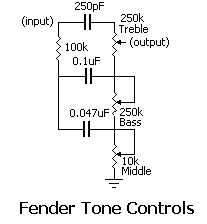
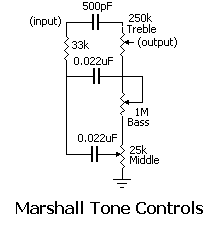
The Fender and Marshall circuits are each tailored to suit their own styles, which are quite different. Although a generalisation, Fender's market and power output stage are geared towards provided clean and chunky tones at clean and early-overdrive levels. Marshall amps are best at low-middly and crunchy rock tones, played at medium to high overdrive levels.
Here are some frequency response plots showing the range and effect of Fender and Marshall tone controls. These are screen captures from the excellent Tone Stack Windows program developed by Duncan Munro. If you're interested in this sort of thing, you can download the program from Duncan's website.
Here is a simple comparison of Marshall and Fender response with what might loosely be called 'typical settings' of Bass on 3, Middle on 4, and Treble on 6. The most obvious difference is that the Marshall lets more level through, and their tone controls have less range of adjustment. The higher level means that by using the same number of preamp valve stages, a Marshall can overdrive the output stage more.
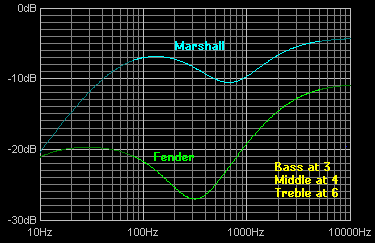
Bearing in mind that 6-string guitar notes don't go below 80Hz, and typical guitar speakers cut above about 5KHz, these responses are similar. Both have a middle dip that is primarily compensation for typical pickups' middle emphasis, rather than an obvious dip in middle response. The Marshall circuit has this cut about an octave higher than the Fender, leaving the low mids and bass intact for that full Marshall sound. On the other hand, Fender's tone controls allow high-mids to pass with the treble response, and add little bass boost for the sparkling and tight sounds they're famous for.
Here are charts each of the Fender controls. In all cases, the other two controls are left at 5. For example, the treble chart shows he effect of varying Treble from 0 to 10, with Bass and Middle both at 5. Notice that all controls have a wide range of adjustment, and that the bass control has most effect from 0 to about 3. Anyone's who has used a Fender will know this, and this control could easily be replaced by a control with a stronger logarithmic taper to smooth this out without changing the range of available tones.
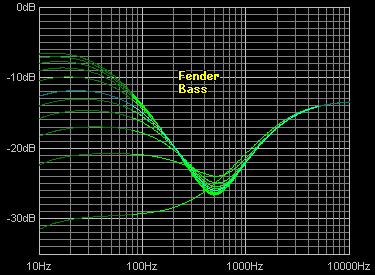
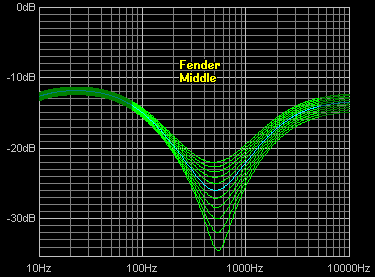
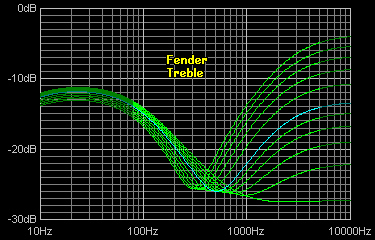
The Fender circuit also has the unusual side effact that if all controls are set to 0, then no sound is produced at all. The Marshall design avoids this, but the tone with all controls set to 0 is not something you'd be likely to use anyway.
Here are the same charts for Marshall tone controls. As mentioned already, the main points to note are the smaller range of adjustment, the higher frequency for the middle cut control, and the higher overall signal level. The smaller adjustment range and higher level are both caused by the use of the 33K resistor in place of Fender's 100K. The also gives the tone stack a lower input impedance, requiring it to be fed from a lower output impedance (cathode follower) preamp valve stage.
Valve power amplifiers often provide an additional presence control (which reduces negative feedback in the power amplifier section) to provide a small amount of boost at frequencies above the treble control.
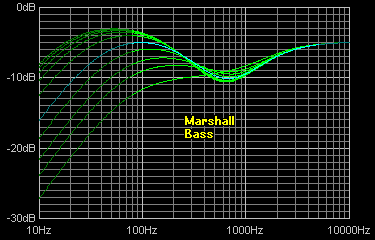
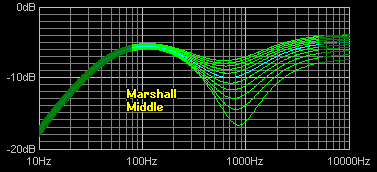
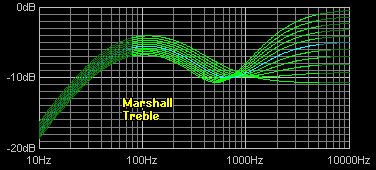
Wide Dynamic Range: A plucked guitar string requires a wide dynamic range to handle the initial peak, then cleanly amplify the decaying string vibrations. Some poor designs do not have this capability in their preamp stages, let alone the power amp to handle this. Pre-amplifier stages need generous power rails, and should not have gain stages which cause the initial plucked part of the string sustain envelope to be clipped.
Use Instrument Speakers. Unlike hi-fi speakers, which are designed to keep the coil entirely within the magnetic field to maximise linearity, instrument speakers are designed to have the coil partially leave the magnetic field at the extremes of cone travel. This is partly to protect the speaker, but also produces a "soft-clipping" effect which is desirable with guitar amplifiers. It is also therefore important to match speaker power ratings reasonably closely with the power of the amplifier. Popular instrument speakers are available from Electro Voice (EV), Celestion and J B Lansing (JBL).
Durability. Most musical styles will require the amplifier to be overdriven for extended periods of time, and the amplifier must be designed to provide this without duress on any components. Common non-guitar design principles assume that circuitry will be designed to avoid overdrive, and technicians working in this field have to "un-learn" many basic assumptions. Popular circuits have evolved through trial and error, due to a general lack of documented knowledge in the field of non-linear amplification.
Road Worthiness. Musical equipment of this type needs both physical and electrical protection. A band often has its equipment transported and set up by a road crew with little guarantee of physical care. Likewise, an assumption should be made that the output stage will at times be inadvertently shorted, so most professional equipment is designed to handle this contingency, preferably electronically, and at the very least without internal fuses.
Do It Yourself?
As technology develops, I'm less convinced that it is practical for do-it-yourselfers to build their own guitar amplifiers and preamplifiers.
Certainly, valve amplifier components (particularly output transformers) are becoming less common as separately available items. While the cost of professional valve amplifiers are much higher than the equivalent solid state designs, they are fair and competitive. In addition, you get a well designed unit with good reliability and a guarantee.
Likewise, recent solid state designs minimise the undesirable features of this technology, and are also available at a fair price. There is still scope to build overdrive circuits such as the one shown on my Overdrive & Distortion page, either as a stand-alone device mounted in a foot pedal, or built into a preamplifier. There has been little development of this technology over the last 10 years; most recent modifications have provided additional flexibility, and several original classics have been repackaged.
Recent digital overdrive designs are showing considerable potential by software emulation of valve amplifier overdrive and dynamic response characteristics, in conjunction with speaker box simulations. These are more flexible and controllable than analog designs, and AD/DA converters have also improved dramatically since some early efforts. I expect that these will further improve and become cheaper in the future.
While components and technology for digital processing are readily available, there is an enormous research effort required, and it is not in the interests of companies who have made this effort to share their knowledge. For this reason, I don't believe these devices are a viable home construction proposition, however, it's always fun to learn and experiment!
Explore More:
Guitar Amplifier Basics
How Guitar Amplifiers Are Used
Guitar Amplifiers - Overdrive & Distortion
Guitar Amplifiers - Valve Emulations
Guitar Amplifiers: Power and Volume
Home | Audio | DIY | Guitar | iPods | Music | Links | Brain and Problem Solving | Site Map | Contact